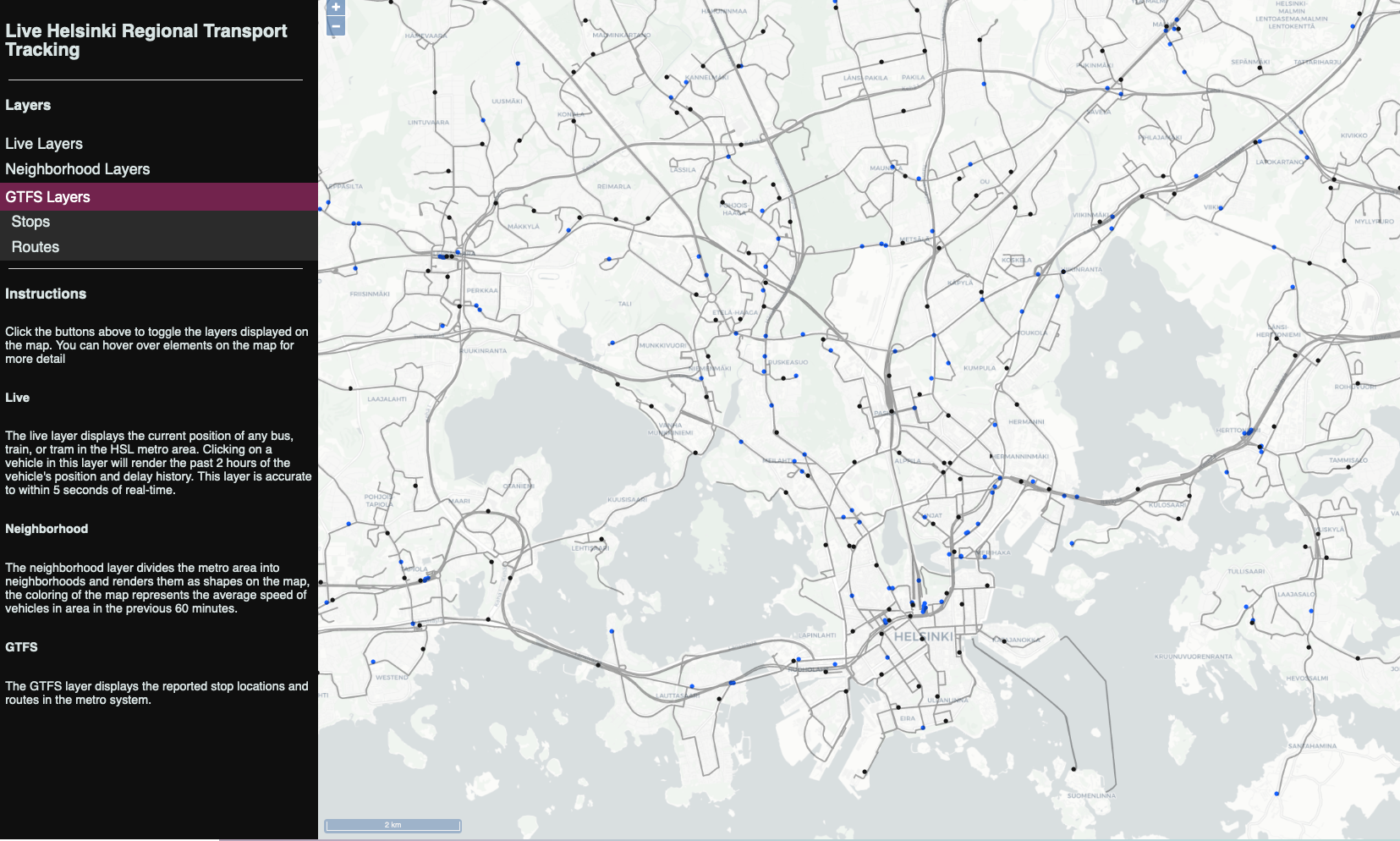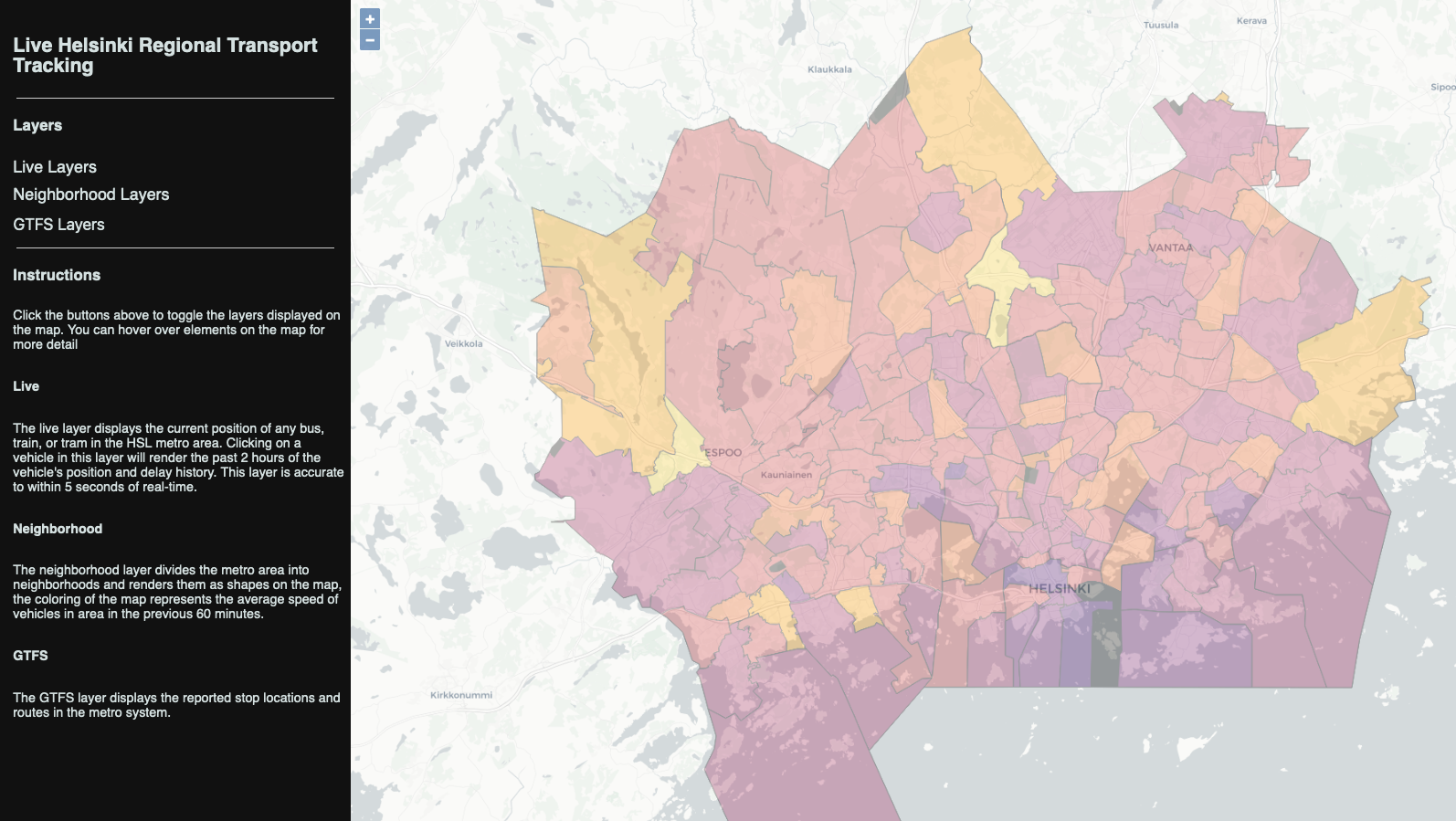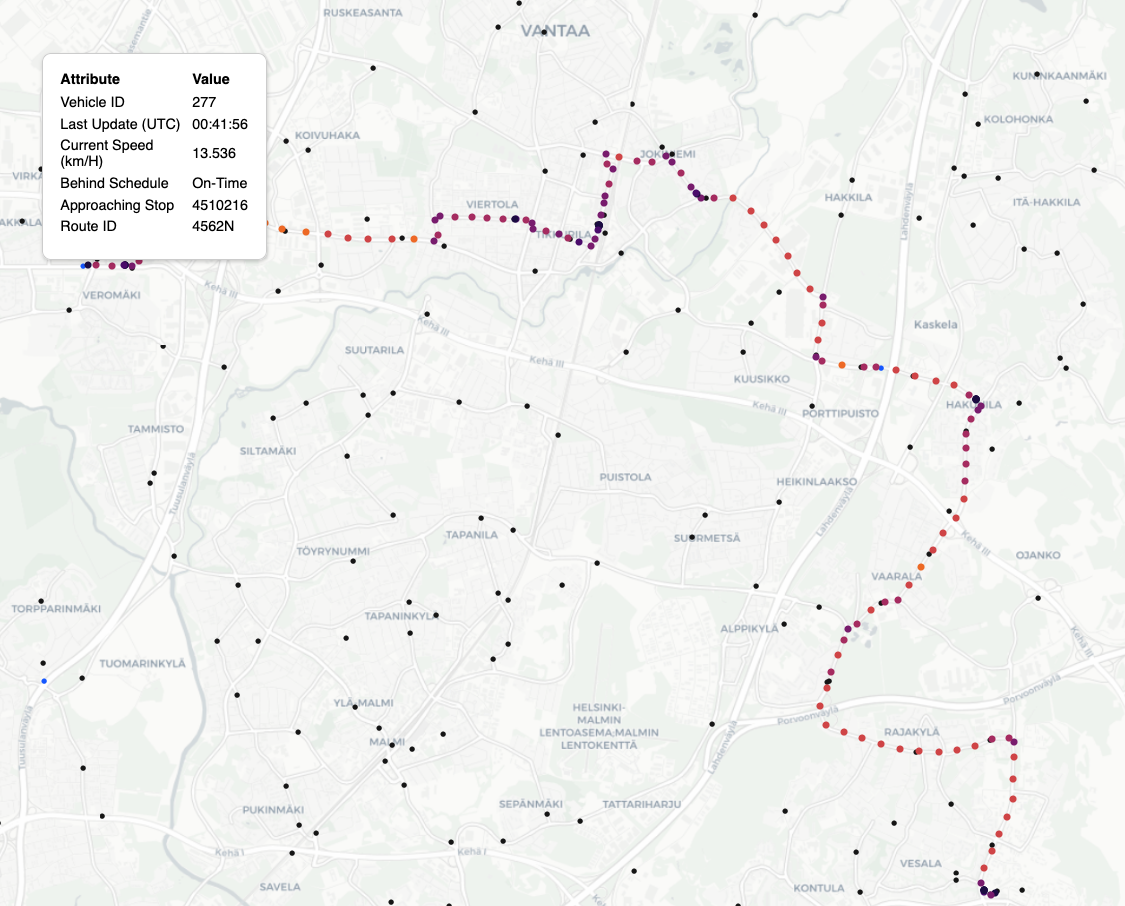This project publishes realtime locations of municipal transport vehicles in the Helsinki metro area to a web UI. Although Helsinki offers a great realtime API for developers, there is no such site that makes this data generally available to the public.1
This is an awesome service that Helsinki provides. Given that HSL publishes on the order of ~50 million updates per day, I felt that Redis would be a great tool to use given the robustness of the TimeSeries Module to quickly aggregate tens of thousands of datapoints, and the Redis Gears module's ability to run batch jobs off the main thread.
A live version of this project is running online at https://maphub.dev/helsinki
UI with GTFS (black) and live-location (blue) layers enabled.
UI with the current traffic layer enabled - an hourly summary is aggregated to the neighborhood level and then colored based on vehicle speed in the area.
UI with the trip history layer and tooltip showing details of vehicle's current status. Coloring maps to vehicle's contemporaneous speed.
- Helsinki Transit System - Real-Time Vehicle Tracking with Redis
Data is sourced from the Helsinki Regional Transit Authority via a public MQTT feed. Incoming MQTT messages are processed through a custom MQTT broker that pushes them to Redis.
MQTT messages are delivered in 2 parts, message topic and message body. Consider the example message below for demonstrations sake:
# Topic - Delivered as Msg Part 1
/hfp/v2/journey/ongoing/vp/bus/0018/00423/2159/2/Matinkylä (M)/09:32/2442201/3/60;24/16/58/67
# Body - Delivered as Msg Part 2
{
"VP": {
"desi": "159",
"dir": "2",
"oper": 6,
"veh": 423,
"tst": "2021-05-15T06:40:28.629Z",
"tsi": 1621060828,
"spd": 21.71,
"hdg": 67,
"lat": 60.156949,
"long": 24.687111,
"acc": 0,
"dl": -21,
"odo": null,
"drst": null,
"oday": "2021-05-15",
"jrn": 202,
"line": 1062,
"start": "09:32",
"loc": "GPS",
"stop": null,
"route": "2159",
"occu": 0
}
}Once in Redis, the data is fanned out to a stream, a pub/sub channel, and multiple time series.
-
Event data sent to a stream is processed with a Redis Gears function and written to persistent storage (PostgreSQL). Once in PostgreSQL, this data is processed hourly and used to generate MapBox tiles for the current traffic layer.
-
Event data sent to the PUB/SUB channel is forwarded to each connected client via websocket. This allows for live updates of positions in the browser on the live-location layer.
-
Time series data is split into separate series for for position (geohash, represented as int) and speed for each scheduled trip. These timeseries are then compacted and served to the frontend by a Golang API which allows the user to access a trip history layer.
The remainder of this document will go through the application in a bit more detail, including local deployment of the application, Redis commands used in each stage & system traffic and architecture.
A functional version of the system can be spun up locally with docker-compose. This will spin up (almost) all services required to run a local demo in their own isolated environments. The service will be running on http://localhost:8080/.
docker-compose up --buildThe following command can be run if you're interested in receiving periodic updates to the traffic speeds/neighborhoods layer. This is not strictly necessary as it can take several hours to gather sufficient data to get a reasonable amount of data (and you'd still need to wait to the tilegen job to come around to repopulate layers).
docker exec <name of redis container> \ # (e.g. redis_hackathon_redis_1)
bash -c "gears-cli run /redis/stream_writebehind.py --requirements /redis/requirements.txt"All components of the app are hosted on single AWS t3.medium with a gp3 EBS volume. In retrospect, while the t3.medium is appealing because of burstable CPU, a smaller instance could handle the application in it's current state.
The MQTT broker is a Golang service that subscribes to a MQTT feed provided by the Helsinki Transit Authority. This service pushes MQTT message data to Redis after processing the message. More about the real-time positioning data from the HSL Metro can be found here. The broker is responsible for writing an incoming message from the MQTT feed to each of the following locations:
The incoming event is published to a PUB/SUB channel in Redis. This component (the mqtt broker) uses Golang as a Redis client and uses the code/command below.
// In Golang...
pipe := client.TxPipeline()
ctx := client.Context()
// Stylizing the Actual Message Body for Readme
msg := &hsl.EventHolder{
"acc": 0.1, "speed": 10.6, "route": "foo"
}
pipe.Publish(
ctx, "currentLocationsPS", msg
)# Using a standard Redis client...
127.0.0.1:6379> PUBLISH currentLocationsPS '{"acc": 0.1, "speed": 10.6, "route": "foo"}'The incoming event is pushed to a stream. This stream is later cleared and processed by code that runs via Redis Gears. As with the PUB/SUB channel, this is written using the Redis Go Client shown below.
// In Golang...
pipe.XAdd(
ctx, &redis.XAddArgs{
Stream: "events",
Values: []interface{}{
"jid", journeyID,
"lat", e.VP.Lat,
"lng", e.VP.Lng,
"time", e.VP.Timestamp,
"spd", e.VP.Spd,
"acc", e.VP.Acc,
"dl", e.VP.DeltaToSchedule,
},
},
)# Using a standard Redis client...
127.0.0.1:6379> XADD events * jid journeyhashID lat 60 lng 25 time 1620533624765 speed 10 acc 0.1 dl "00:00"The incoming event is pushed to several time series. A unique identifier is created for each "trip" (referred to as JourneyHash) hashing certain attributes from the event. The broker creates a time series for both speed and location for each journeyhash.
-
Location data is stored in a time series by encoding a (lat, lng) position to an integer representation (much like Redis does internally for
GEO.XXXcommands). -
Speed data is simply stored as m/s, as it appears in the original MQTT message.
The position and speed series have a short retention and are compacted to secondary time series. These compacted series have a much longer retention time (~2hr) and are used by the API to show users the trip history layer. By quickly expiring/aggregating individual events, this pattern allows us to keep memory usage much lower.
As with previous sections, the commands are executed by Golang. As the standard Golang client does not include the TS.XXX commands, I will forgo showing the Go written for this section.
First, I check to see if a journeyhash has not yet been seen by checking it's inclusion in a set (journeyID). If the following returns 1, I proceed with creating series and rules, else, I just TS.ADD the data.
SADD journeyID <JOURNEYHASH>The first series is created with the following command. For the remainder of this section, I'll refer to these as Time Series A
127.0.0.1:6379> TS.CREATE positions:<JOURNEYHASH>:speed
127.0.0.1:6379> TS.CREATE positions:<JOURNEYHASH>:ghThe aggregation series are fed by the "main" timeseries and created with the command below. I'll refer to these as Time Series B
127.0.0.1:6379> TS.CREATE positions:<JOURNEYHASH>:speed:agg RETENTION 7200000 LABELS speed 1 journey <JOURNEYHASH>
127.0.0.1:6379> TS.CREATE positions:<JOURNEYHASH>:gh:agg RETENTION 7200000 LABELS gh 1 journey <JOURNEYHASH>For the rule that governs Time Series A -> Time Series B, I use the following command:
127.0.0.1:6379> TS.CREATERULE positions:<JOURNEYHASH>:speed positions:<JOURNEYHASH>:speed:agg AGGREGATION LAST 150000
127.0.0.1:6379> TS.CREATERULE positions:<JOURNEYHASH>:gh positions:<JOURNEYHASH>:gh:agg AGGREGATION LAST 150000To add data to Time Series A I use the following:
127.0.0.1:6379> TS.ADD positions:<JOURNEYHASH>:speed * 10 RETENTION 60000 CHUNK_SIZE 16 ON_DUPLICATE LAST
127.0.0.1:6379> TS.ADD positions:<JOURNEYHASH>:gh * 123456123456163 RETENTION 60000 ON_DUPLICATE LASTIn the example above, 123456123456163 is a fake number which represents a integer encoding of a geohash coordinate to integer encoding was handled in Go with this package.
I use a Docker image that is almost identical to redislabs/redismod:latest (see: Dockerfile) as the base image for this project. The only significant difference is that this container contains a RedisGears function which implements a write-behind pattern.
This function consumes from a stream and writes data to PostgreSQL/PostGIS every 5s/10,000 events. Even though Gears runs off the main thread, this function is designed to do minimal data-processing. This function simply dumps MQTT event data into PostGIS and allows the PostGIS and Tilegen processes to transform these events to MBtiles.
The RedisGears function is written in Python and doesn't call any Redis commands; See function.
The PostGIS and Tilegen containers are crucial in serving GTFS and current traffic layers.
PostGIS is a PostgreSQL extension that enables geospatial operations.
TileGen is an alpine container that contains two common utilities used in geospatial processing, GDAL and tippecanoe (and psql, the PostgreSQL client). This container is required for:
- Sourcing static data and pushing it to PostGIS with GDAL
- Periodic regeneration of tiles using Tippecanoe
The TilesAPI is a simple Golang API which is used to fetch those tiles from disk and send them to the frontend.
The Locations API has two endpoints /locations/ and /histlocations/.
-
/locations/subscribes to the Redis PUB/SUB channel described earlier. When a client connects to this endpoint, the connection is upgraded and events are pushed along to the client in real-time. -
/histlocations/queries a specific trip timeseries in Redis usingTS.MRANGE; the API takes the "merged" result and creates a response of historical positions and speeds for a given trip.
The /locations/ endpoint subscribes/reads data from the PUB/SUB channel defined in the MQTT broker section. While written in Go, the redis-cli command for this would be:
127.0.0.1:6379> SUBSCRIBE currentLocationsPSThe /histlocations/ endpoint needs to gather data from multiple time series to create a combined response for the client, this means making a TS.MRANGE call. Because each Timeseries B is labelled with it's journey hash, the TS.MRANGE gathers the position and speed stats with a single call, filtering on journey hash.
127.0.0.1:6379> TS.MRANGE - + FILTER journey=<JOURNEYHASH>The frontend uses OpenLayers, a JS library, to create a map and display the layers created by the previously described services. In production, this is served using Nginx rather than Parcel's development mode.
The frontend also makes calls to a publicly available API for basemap imagery.
This system is not explicitly architected to handle huge amounts of data, but it does perform acceptably given this (relatively small scale) task. Anecdotally, the system processes ~15GB of messages per day when subscribed to the MQTT topic corresponding to all bus position updates.
The following charts display the rise in event throughput on a Sunday morning into afternoon and evening. Notice that towards the middle of the day the events/second top out at 500/s (30k events/min shown on graph) after growing steadily from < 10 events/s (1k events/minute) early in the morning.
Alternatively, on a weekday morning at 8:00am, we can see the system handling ~1600+ events/s relatively comfortably. Consider the following stats from a five minute window the morning of 5/14/2021.
select
now(), -- UTC
count(1)/300 as eps -- averaged over prev 300s
from statistics.events
where approx_event_time > now() - interval'5 minute';
now | eps
-------------------------------+------
2021-05-14 05:06:28.974982+00 | 1646In local testing, I found the most stressed part of the system wasn't CPU as I had originally suspected, but instead the disk. See the capture below for the docker stats from 8:00am 5/14/2021.
CONTAINER ID NAME CPU % MEM USAGE / LIMIT MEM % NET I/O
6d0a1d7fab0d redis_hackathon_mqtt_1 24.02% 10.71MiB / 3.786GiB 0.28% 32GB / 60.4GB
833aab4d39a8 redis_hackathon_redis_1 7.02% 862.7MiB / 3.786GiB 22.26% 58.8GB / 38.9GBUpgrading from AWS standard gp2 EBS to gp3 EBS allowed me to get 3000 IOPs and 125MB/s throughput essentially for free and made hosting the PostgreSQL instance in a container viable. Without a robust disk, the site still functioned, however tile generation was quite slow and could lag 10+ minutes. As I'd like to expand this component to allow for 30m, 1h, 2h, 6h traffic layers, being able to get historical positions from disk quickly was crucial.
Prior to upgrade, system load was very high due to the write-behind from gears (writing to disk) and tile generation (from disk). With the update, even during rush-hour (decoding/encoding messages -> CPU Heavy) and tile regeneration (Both Disk & CPU heavy), %iowait stays low and system load stays < 1. Consider the following results from sar during a tile regeneration event
CPU %user %system %iowait %idle
20:00:07 all 9.98 9.88 47.08 32.56
# PostgreSQL Aggregations - Disk Heavy --
20:00:22 all 10.22 12.04 41.70 35.22
20:00:37 all 10.46 10.66 61.73 16.95
20:00:52 all 34.89 11.97 34.48 18.56
20:01:07 all 8.00 8.51 55.59 26.97
# Tilegeneration - User Heavy --
20:01:22 all 32.93 8.13 26.42 32.42
20:01:37 all 48.94 10.90 21.29 18.87
# Back to High Idle % --
20:01:47 all 7.19 4.39 5.89 81.24Due to the time series policy which sets TTL on entries for 1m in series A / 2h in series B and the Gears function constantly clearing the event stream, the Redis memory usage stays fairly constant around 800-900MB.
1 I am not a resident of Helsinki, my knowledge of the transit authority's product offerings is limited by both a lack of familiarity with the city and the Finnish language.





